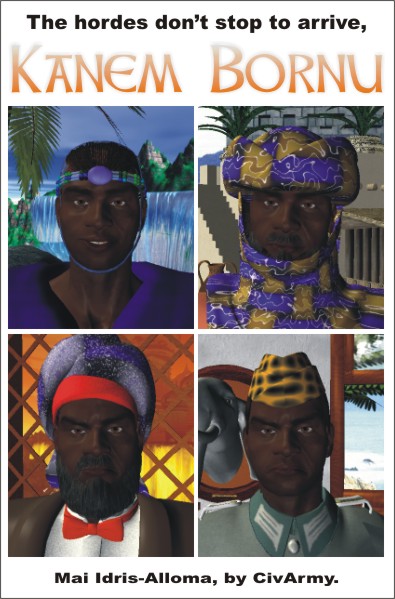CivArmy s. 1994
Deity
The files are:
http://www.civfanatics.net/uploads9/Kanem-Bornu01.zip
http://www.civfanatics.net/downloads/civ3/graphics/Kanem-Bornu02.zip
Civilization: Kanem-Bornu
Bonuses: Commercial and Militaristic
Title and leader: Mai Idris-Alloma
Best/shunned government: Fascism (Monarchy) and Democracy
Aggression: 05 (much high)
Cultural group: Mid East
Noun: Kanuri-Bornu
Adjective: Kanuri-Bornu
Colors: Black (Zulu) and Brow (Russia)
UU: Tunisian Musketeer
Civilopedia entry: RACE_KANEM-BORNU

Cities:
Njima
Manan
Ngazargamu
Bornu
Wudi
Birni Kimi
Yamia
Birni Ngazargamu
NDjaména
Yaounde
Niamey
Mao
Abeche
Koro Toro
Fada
Faya
Aozou
Sarh
Moundou
Kribi
Douala
Tiko
Nkongsamba
Bafoussam
Bamenda
Ngaoundéré
Garoua
Maroua
Birni Ngaouré
Tillabéri
Ayorou
Tabia
Loga
Tahoua
Madaoua
Abalak
Maradi
Tessaoua
Magaria
Zinder
Gouré
Tanout
Agadez
Arlit
Diffa
Maïne Soroa
Agadem
Bilma
Djado
Madama
Military leaders:
Dunama Dibbalemi
Mahamad Al-Kanemi
Omar Al-Kanemi
Rabah Fadlallah
Scientific ones:
Ali Gaji
Ibrahim
Umar ibn Idris
Civilopedia:
It is present and u can see it inside your Civilization 3.
Tunisian Musketeer, the UU:
Replaces Musketman, has two extra offensive points and cost 10 shields more. This unit was used to fight against other nations that were under Kanuri-Bornu control. This domination turned possible happen the slavery commerce between Europe and this African Empire.
Icon

Default

Run

Death

Victory

Attack

http://www.civfanatics.net/uploads9/Kanem-Bornu01.zip
http://www.civfanatics.net/downloads/civ3/graphics/Kanem-Bornu02.zip
Civilization: Kanem-Bornu
Bonuses: Commercial and Militaristic
Title and leader: Mai Idris-Alloma
Best/shunned government: Fascism (Monarchy) and Democracy
Aggression: 05 (much high)
Cultural group: Mid East
Noun: Kanuri-Bornu
Adjective: Kanuri-Bornu
Colors: Black (Zulu) and Brow (Russia)
UU: Tunisian Musketeer
Civilopedia entry: RACE_KANEM-BORNU

Cities:
Njima
Manan
Ngazargamu
Bornu
Wudi
Birni Kimi
Yamia
Birni Ngazargamu
NDjaména
Yaounde
Niamey
Mao
Abeche
Koro Toro
Fada
Faya
Aozou
Sarh
Moundou
Kribi
Douala
Tiko
Nkongsamba
Bafoussam
Bamenda
Ngaoundéré
Garoua
Maroua
Birni Ngaouré
Tillabéri
Ayorou
Tabia
Loga
Tahoua
Madaoua
Abalak
Maradi
Tessaoua
Magaria
Zinder
Gouré
Tanout
Agadez
Arlit
Diffa
Maïne Soroa
Agadem
Bilma
Djado
Madama
Military leaders:
Dunama Dibbalemi
Mahamad Al-Kanemi
Omar Al-Kanemi
Rabah Fadlallah
Scientific ones:
Ali Gaji
Ibrahim
Umar ibn Idris
Civilopedia:
It is present and u can see it inside your Civilization 3.
Tunisian Musketeer, the UU:
Replaces Musketman, has two extra offensive points and cost 10 shields more. This unit was used to fight against other nations that were under Kanuri-Bornu control. This domination turned possible happen the slavery commerce between Europe and this African Empire.
Icon

Default

Run

Death

Victory

Attack



 BTW, thanks for advise me
BTW, thanks for advise me 